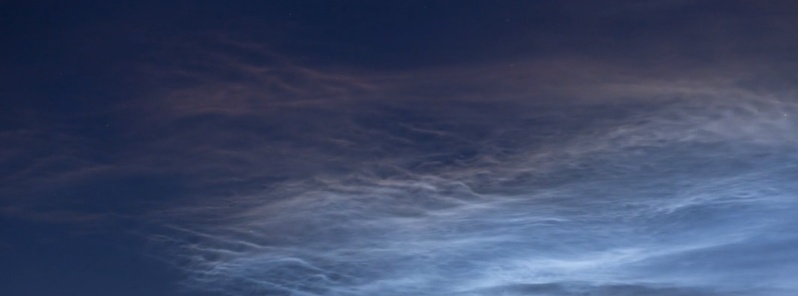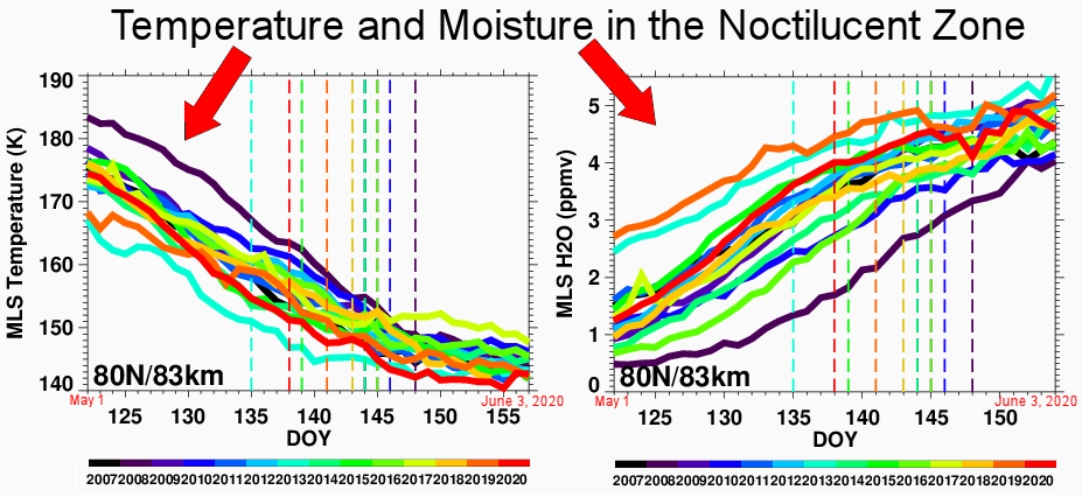Rare dark red noctilucent clouds appear over Sweden

Rare dark red noctilucent clouds appeared over Vallentuna, Sweden on July 25, 2020, and were recorded by P-M Heden.
This type of NLCs is rare and not fully understood, Dr. Tony Phillips of the SpaceWeather.com reports.
Research in the 1970s revealed that much of the sunlight hitting noctilucent clouds first passes through Earth's ozone layer, absorbing red light and allowing blue to pass, Phillips explains. "This filtered light gives NLCs an azure hue."
However, the origin of red is less certain and remains a mystery.
"One idea, probably the best, comes from a 1988 paper in the Journal of Atmospheric and Terrestrial Physics entitled "The coloured edge of noctilucent clouds."
The authors note that "Noctilucent clouds are illuminated by sunlight which passes obliquely through the atmosphere. The lowest rays may pass only a few kilometers above sea level." These low rays are strongly reddened (like sunsets) and bent by refraction and some of them redirected to the tops of NLCs.
On July 5 and 6, 2020, observers across Europe, from Scandinavia to the Adriatic coast, reported a major NLC outbreak. The outbreak came on the heels of July 4th sighting over southern California, U.S. — where in 2019 a record was set for the lowest-latitude NLC appearance in known history.
Temperatures at the mesosphere have recently broken a 14-year record, causing noctilucent clouds to spill across the Arctic and descend to middle latitudes.
To find out more about the occurrence, Lynn Harvey of the University of Colorado's Laboratory for Atmospheric and Space Physics has taken a look at moisture and temperature data — key ingredients of NLCs — collected by NASA's Microwave Limb Sounder (MLS).
"The data showed that 2020 is shaping up to be a very cold and wet year," Harvey said.


Image credit: Space Weather Gallery
"Temperatures, in particular, are very cold. In fact, mid-latitude (35N-55N) temperatures in late May (DOY 142-148) were the coldest of the AIM record." This was since 2007 when NASA's AIM spacecraft started tracking noctilucent clouds.
Last summer, NLCs spread as far south as Los Angeles and Las Vegas, U.S. for the first time in known history.
On Friday morning, June 14, 2019, Don Davis observed NLCs from the city of Joshua Tree near Los Angeles, California.
"They were dim but distinct. I photographed them easily using a 4-second exposure at ISO 400," he said.
Davis’s sighting at +34.1 degrees sets the record for low-latitude observations of NLCs, breaking the previous record set only five days earlier by senior meteorologist Brian Guyer at the National Weather Service in Albuquerque, New Mexico (+35.1 degrees).
"I'm shocked to report that I saw the noctilucent clouds while venturing outdoors for a weather observation shortly after sunset," Guyer said.
"When I noticed the faint blue wavy tendrils far off to the north, I asked myself, ‘am I really seeing noctilucent clouds from here?’ I’m happy to see that other folks are also seeing these beautiful spectacles of nature at lower latitudes."
Featured image: P-M Heden, Earth To Sky Calculus

its easy aluminium oxide sprayed by planes and ships.